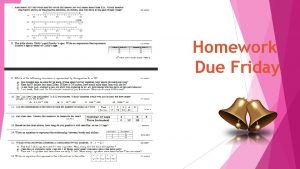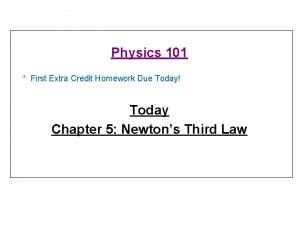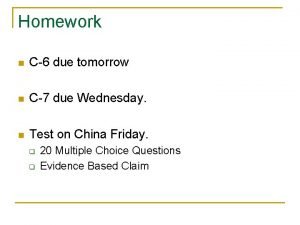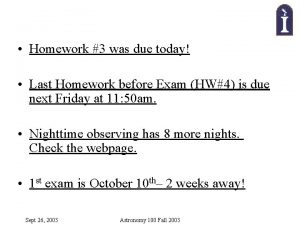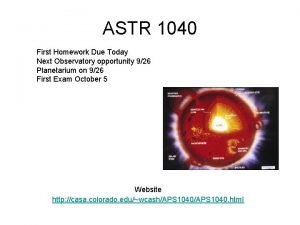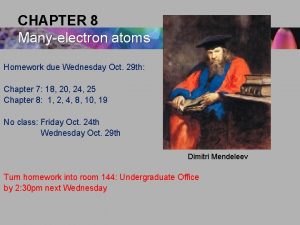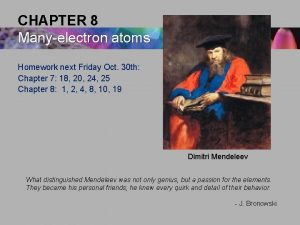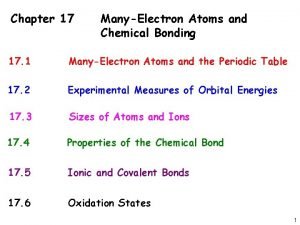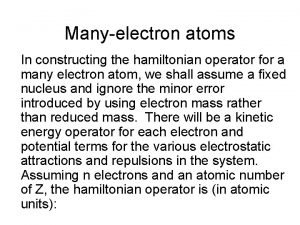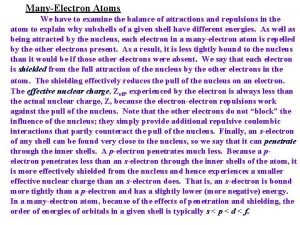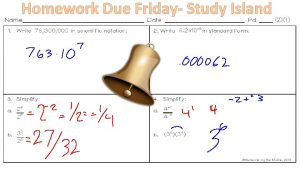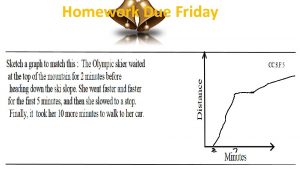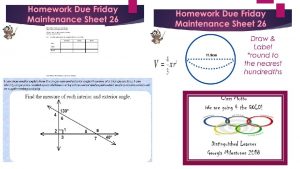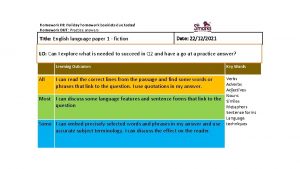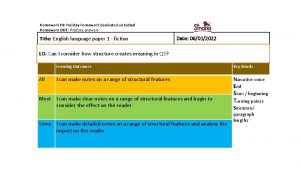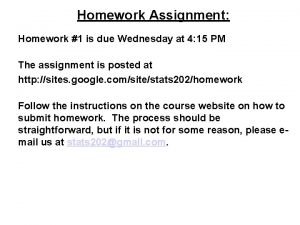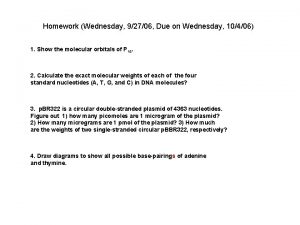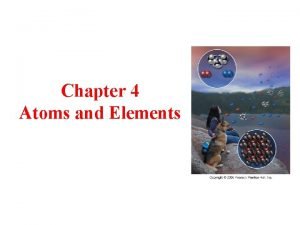CHAPTER 8 Manyelectron atoms Homework due Wednesday Chapter























- Slides: 23

CHAPTER 8 Many-electron atoms Homework due Wednesday: Chapter 7: problems 1, 4, 5, 6, 7, 8, 10, 12, 14, 15 Dimitri Mendeleev What distinguished Mendeleev was not only genius, but a passion for the elements. They became his personal friends; he knew every quirk and detail of their behavior. - J. Bronowski

Intrinsic Spin In 1925, grad students, Samuel Goudsmit and George Uhlenbeck, in Holland proposed that the electron must have an intrinsic angular momentum and therefore a magnetic moment. Paul Ehrenfest showed that, if so, the surface of the spinning electron should be moving faster than the speed of light! In order to explain experimental data, Goudsmit and Uhlenbeck proposed that the electron must have an intrinsic spin quantum number s = ½.

Intrinsic Spin As with orbital angular momentum, the total spin angular momentum is: The z-component of the spinning electron is also analogous to that of the orbiting electron: So Sz = m s ħ Because the magnetic spin quantum number ms has only two values, ±½, the electron’s spin is either “up” (ms = +½) or “down” (ms = -½).

What about Sx and Sy? As with Lx and Ly, quantum mechanics says that, no matter how hard we try, we can’t also measure them! If we did, we’d measure ±½ ħ, just as we’d find for Sz. But then this measurement would perturb Sz, which would then become unknown! The total spin is , so it’d be tempting to conclude that every component of the electron’s spin is either “up” (+½ ħ) or “down” (ms = -½ ħ). But this is not the case! Instead, they’re undetermined. We’ll see next that the uncertainty in each unmeasured component is equal to their maximum possible magnitude (½ ħ)!

Generalized Uncertainty Principle Define the Commutator of two operators, A and B: If this quantity is zero, we say A and B commute. Then the uncertainty relation between the two corresponding observables will be: So if A and B commute, the two observables can be measured simultaneously. If not, they can’t. Example: So: and

Uncertainty in angular momentum and spin We’ve seen that the total and z-components of angular momentum and spin are knowable precisely. And the x and ycomponents aren’t. Here’s why. It turns out that: and Using: We find: So there’s an uncertainty relation between the x and y components of orbital angular momentum. And the same for spin. Measurement of one perturbs the other.

Two Types of Uncertainty in Quantum Mechanics 1. Some quantities (e. g. , energy levels) can, at least in principle, be computed precisely, but some cannot (e. g. , Lx and Lz simultaneously). Even if a quantity can, in principle, be computed precisely, the accuracy of its measured value can still be limited by the Uncertainty Principle. For example, energies can only be measured to an accuracy of ħ /Dt, where Dt is how long we spend doing the measurement. 2. And there is another type of uncertainty: we often simply don’t know which state an atom is in. It can be in a superposition of states

Stationary states are stationary. But an atom can be in a superposition of two stationary states, and this state moves. Energy Superposition of states Excited level, E 2 DE = h n Ground level, E 1 where |ai|2 is the probability that the atom is in state i. Interestingly, this lack of knowledge means that the atom is vibrating: Vibrations occur at the frequency difference between the two levels.

Operators and Measured Values In any measurement of the observable associated with an operator A, ˆ the only values that can ever be observed are the eigenvalues. Eigenvalues are the possible values of a in the Eigenvalue Equation: where a is a constant and the value that is measured. For operators that involve only multiplication, like position and potential energy, all values are possible. But for others, like energy and momentum, which involve operators like differentiation, only certain values can be the results of measurements.

Chapter 8: Atomic Structure and the Periodic Table What if there’s more than one electron? Helium: a nucleus with charge +2 e and two electrons, the two electrons repelling one another. Cannot solve problems exactly with the Schrödinger equation because of the complex potential interactions. Can understand experimental results without computing the wave functions of many-electron atoms by applying the boundary conditions and selection rules.

Multi-electron atoms When more than one electron is involved, the potential and the wave function are functions of more than one position: Solving the Schrodinger Equation in this case can be very hard. But we can approximate the solution as the product of singleparticle wave functions: And it turns out that we’ll be able to approximate each Yi with a Hydrogen wave function.

Pauli Exclusion Principle To understand atomic spectroscopic data, Pauli proposed his exclusion principle: No two electrons in an atom may have the same set of quantum numbers (n, ℓ, ms). It applies to all particles of half-integer spin, which are called fermions, and particles in the nucleus are also fermions. The periodic table can be understood by two rules: The electrons in an atom tend to occupy the lowest energy levels available to them. The Pauli exclusion principle.

Atomic Structure Hydrogen: (n, ℓ, ms) = (1, 0, 0, ±½) in ground state. In the absence of a magnetic field, the state ms = ½ is degenerate with the ms = −½ state. Helium: (1, 0, 0, ½) for the first electron. (1, 0, 0, −½) for the second electron. Electrons have anti-aligned (ms = +½ and ms = −½) spins. The principle quantum number also has letter codes. n= 1 2 3 4. . . Letter = K L M N… n = shells (eg: K shell, L shell, etc. ) nℓ = subshells (e. g. : 1 s, 2 p, 3 d) Electrons for H and He atoms are in the K shell. H: 1 s He: 1 s 2

Atomic Structure How many electrons may be in each subshell? Total For each mℓ: two values of ms 2 For each ℓ: (2ℓ + 1) values of mℓ 2(2ℓ + 1) Recall: ℓ = 0 1 2 3 4 5 … letter = s p d f g h … ℓ = 0, (s state) can have two electrons. ℓ = 1, (p state) can have six electrons, and so on. Electrons with higher ℓ values are more shielded from the nuclear charge. Electrons with higher ℓ values lie higher in energy than those with lower ℓ values. 4 s fills before 3 d.

The Periodic Table

Inert Gases: Last group of the periodic table Closed p subshell except helium Zero net spin and large ionization energy Their atoms interact weakly with each other Alkalis: Single s electron outside an inner core Easily form positive ions with a charge +1 e Lowest ionization energies Electrical conductivity is relatively good Alkaline Earths: Two s electrons in outer subshell Largest atomic radii High electrical conductivity The Periodic Table

The Periodic Table Halogens: Need one more electron to fill outermost subshell Form strong ionic bonds with the alkalis More stable configurations occur as the p subshell is filled Transition Metals: Three rows of elements in which the 3 d, 4 d, and 5 d are being filled Properties primarily determined by the s electrons, rather than by the d subshell being filled Have d-shell electrons with unpaired spins As the d subshell is filled, the magnetic moments, and the tendency for neighboring atoms to align spins are reduced

Lanthanides (rare earths): Have the outside 6 s 2 subshell completed As occurs in the 3 d subshell, the electrons in the 4 f subshell have unpaired electrons that align themselves The large orbital angular momentum contributes to the large ferromagnetic effects Actinides: Inner subshells are being filled while the 7 s 2 subshell is complete Difficult to obtain chemical data because they are all radioactive The Periodic Table

8. 2: Total Angular Momentum Orbital angular momentum Spin angular momentum Total angular momentum L, Lz, S, Sz, J, and Jz are quantized.

Total Angular Momentum If j and mj are quantum numbers for the single-electron hydrogen atom: Quantization of the magnitudes: The total angular momentum quantum number for the single electron can only have the values

Spin-Orbit Coupling An effect of the spins of the electron and the orbital angular momentum interaction is called spin-orbit coupling. The dipole potential energy The spin magnetic moment µ is the magnetic field due to the electron’s orbital motion. ● where a is the angle between .

Total Angular Momentum Now the selection rules for a single-electron atom become Δn = anything Δmj = 0, ± 1 Δℓ = ± 1 Δj = 0, ± 1 Hydrogen energy-level diagram for n = 2 and n = 3 with spin-orbit splitting.

Many-Electron Atoms Hund’s rules: The total spin angular momentum S should be maximized to the extent possible without violating the Pauli exclusion principle. Insofar as rule 1 is not violated, L should also be maximized. For atoms having subshells less than half full, J should be minimized. For a two-electron atom There are LS coupling and jj coupling to combine four angular momenta J.
 Periodic table regents
Periodic table regents Jack prelutsky homework oh homework
Jack prelutsky homework oh homework Homework oh homework i hate you you stink
Homework oh homework i hate you you stink Parts of a poem
Parts of a poem Homework oh homework jack prelutsky
Homework oh homework jack prelutsky Homework oh homework i hate you you stink
Homework oh homework i hate you you stink Literal language example
Literal language example Homework due today
Homework due today Homework is due on friday
Homework is due on friday Homework is due on friday
Homework is due on friday Homework due today
Homework due today Homework due today
Homework due today Ilegalism
Ilegalism Homework
Homework Homework is due
Homework is due 3 weeks from today
3 weeks from today Astr
Astr Homework due today
Homework due today Famiglia dei parallelogrammi
Famiglia dei parallelogrammi Procedural due process vs substantive due process
Procedural due process vs substantive due process Le leggi di dracone
Le leggi di dracone Due piccole sfere identiche sono sospese
Due piccole sfere identiche sono sospese Monday tuesday wednesday thursday friday calendar
Monday tuesday wednesday thursday friday calendar Wednesday evening prayer
Wednesday evening prayer









